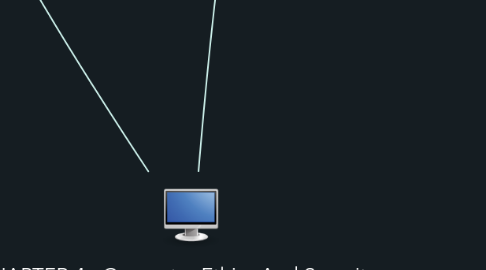
1. Ethics and Privacy
1.1. Computer ethics
1.1.1. are the moral guidelines that govern the use of computers and information systems
1.2. Information accuracy is a concern
1.2.1. Not all information on the Web is correct
1.3. Green computing
1.3.1. involves reducing the electricity and environmental waste while using a computer
1.4. Information privacy
1.4.1. refers to the right of individuals and companies to deny or restrict the collection and use of information about them
1.5. A cookie
1.5.1. a small text file that a Web server stores on your computer
1.6. Web sites use cookies for a variety of reasons
1.6.1. Allow for personalization
1.6.2. Store users’ passwords
1.6.3. Assist with online shopping
1.6.4. Track how often users visit a site
1.6.5. Target advertisements
1.6.6. Scam
1.6.6.1. Phishing
1.6.6.1.1. a scam in which a perpetrator sends an official looking e-mail message that attempts to obtain your personal and financial information
1.6.6.2. Pharming
1.6.6.2.1. a scam where a perpetrator attempts to obtain your personal and financial information via spoofing
2. Safety
2.1. Backing Up – The Ultimate Safeguard
2.1.1. a duplicate of a file, program, or disk that can be used if the original is lost, damaged, or destroyed
2.1.1.1. Two categories of backups
2.1.1.1.1. Full backup
2.1.1.1.2. Selective backup
2.2. Wireless Security
2.2.1. In additional to using firewalls, some safeguards improve security of wireless networks
2.2.1.1. A wireless access point should not broadcast an SSID
2.2.1.2. Change the default SSID
2.2.1.3. Configure a WAP so that only certain devices can access it
2.2.1.4. Use WPA or WPA2 security standards
2.3. Health Concerns of Computer Use
2.3.1. The widespread use of computers has led to health concerns
2.3.1.1. Repetitive strain injury (RSI)
2.3.1.2. Carpal tunnel syndrome (CTS)
2.3.1.3. Computer vision syndrome (CVS)
2.3.2. Ergonomics
2.3.2.1. an applied science devoted to incorporating comfort, efficiency, and safety into the design of items in the workplace
2.3.3. Computer addiction
2.3.3.1. occurs when the computer consumes someone’s entire social life
2.3.4. Symptoms of users include
2.3.4.1. Craves computer time
2.3.4.2. Overjoy when at the computer
2.3.4.3. Unable to stop computer activity
2.3.4.4. Irritable when not at the computer
2.3.4.5. Neglects family and friends
2.3.4.6. Problems at work or school
3. Computer Security Risks
3.1. any event or action that could cause a loss of or damage to computer hardware, software, data, information, or processing capability
3.1.1. Security risks
3.1.1.1. Unauthorized access and use
3.1.1.1.1. Organizations take several measures to help prevent unauthorized access and use
3.1.1.1.2. Access controls define who can access a computer, when they can access it, and what actions they can take
3.1.1.1.3. A possessed object is any item that you must carry to gain access to a computer or computer facility
3.1.1.1.4. A biometric device
3.1.1.1.5. Digital forensics
3.1.1.2. Hardware theft
3.1.1.2.1. the act of stealing computer equipment
3.1.1.3. System failture
3.1.1.3.1. A variety of factors can lead to system failure, including
3.1.1.3.2. Two ways to protect from system failures caused by electrical power variations
3.1.1.4. Information theft
3.1.1.4.1. occurs when someone steals personal or confidential information
3.1.1.5. Software theft
3.1.1.5.1. occurs when someone
3.1.2. Internet and network attacks
3.1.2.1. Computer Virus
3.1.2.1.1. Affects a computer negatively byaltering the way the computer works
3.1.2.2. Worm
3.1.2.2.1. Copies itself repeatedly, using upresources and possibly shutting down the computer or network
3.1.2.3. Trojan Horse
3.1.2.3.1. A malicious program that hides within or looks like a legitimate program
3.1.2.4. Rootkit
3.1.2.4.1. Program that hides in a computer and allows someone from a remote location to take full control
3.1.3. Cybercrime
3.1.3.1. an online or Internet-based illegal act
3.1.3.1.1. Hackers
3.1.3.1.2. Crackers
3.1.3.1.3. Script Kiddies
3.1.3.1.4. Corporate Spies
3.1.3.1.5. Unethical Employees
3.1.3.1.6. Cyberextortionists
3.1.3.1.7. Cyberterrorists
3.2. An infected computer has one or more of the following symptoms
3.2.1. Operating system runs much slower than usual
3.2.2. Available memory is less than expected
3.2.3. Files become corrupted
3.2.4. Screen displays unusual message or image
3.2.5. Music or unusual sound plays randomly
3.2.6. Existing programs and files disappear
3.2.7. Programs or files do not work properly
3.2.8. Unknown programs or files mysteriously appear
3.2.9. System properties change
3.2.10. Operating system does not start up
3.2.11. Operating system shuts down unexpectedly
3.3. Botnet
3.3.1. a group of compromised computers connected to a network
3.3.1.1. zombie
3.4. Denial of service attack (DoS attack)
3.4.1. disrupts computer access to Internet services
3.5. Back door
3.5.1. a program or set of instructions in a program that allow users to bypass security controls
3.6. Spoofing
3.6.1. a technique intruders use to make their network or Internet transmission appear legitimate

